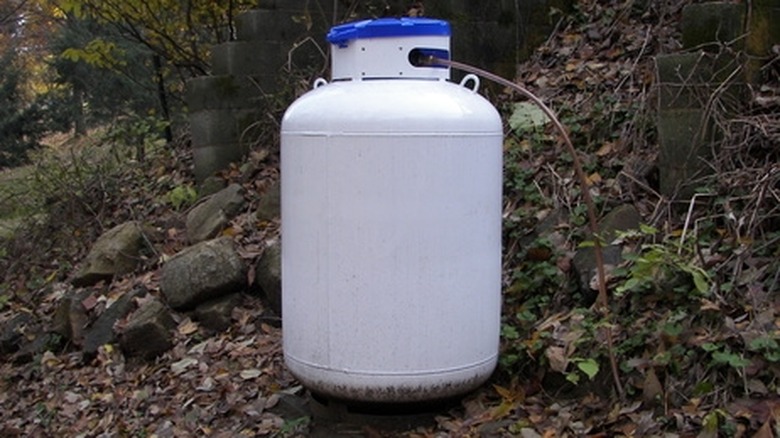How Do Liquid Propane Tanks Work?
Safe Storage of Propane
Propane, whether burned as a gas or liquid, is stored in liquid form in a portable or stationary tank. Small portable tanks are used with gas grills and similar appliances, while stationary tanks are either mounted on legs and typically placed in the backyard of a home or business or buried underground. Stationary liquid propane tanks require care in installation, filling and maintenance.
All propane tanks approved for use must be equipped with a standard series of valves. These include a fill valve for attaching a delivery hose from a truck; a vapor return valve to keep pressure within limits during delivery; a service valve, which converts the liquid gas to vapor; a relief valve to bleed off excess pressure in emergency situations; and a liquid withdrawal valve, which governs the amount of LP gas withdrawn from the tank. Two types of gauges must also be operative: a float gauge that shows the amount of propane in the tank and a fixed liquid level gauge that warns when the level is about to exceed the maximum allowable 80-percent fill.
Installation and Use
Installation and Use
Only a licensed propane company may install a liquid propane storage tank. Such a company is responsible for assuring compliance with all regulations regarding permits and required clearances as well as determining the proper size tank for the planned application. A crane is usually required for installation. After installation is completed and safety checked, company personnel fill the tank and instruct the user in proper operation. The actual operation of liquid propane is simple, because no mechanism or converter is required to take it from a liquid to a gas. Propane has a very low boiling point of 43.6 degrees below 0 F, meaning that it self-vaporizes when released from the pressurized tank at any temperature higher than that. After its discharge through the service valve, the newly gaseous propane travels through pipes to the building, where it is burned in appliances or used as a refrigerant.
Refilling and Maintenance
Refilling and Maintenance
The driver of the installing company will return to fill the tank as needed. The tank must be recertified for safe operation by qualified personnel no less than 12 years after manufacture. That inspection must subsequently be repeated every 5 years. The place of installation should be carefully chosen so as to minimize the chances of banging, flooding or denting the cylinder over the years.
Safety Considerations
Safety Considerations
Private individuals may not self-install liquid propane storage tanks. To ensure consumer safety, all large propane tanks must be built according to the rules of the American Society of Mechanical Engineers (ASME). They must be painted a reflective color, placed level and display a manufacturer's nameplate to be filled. For above-ground tanks, a concrete pad of level concrete blocks must be in place before installation, and a trench that matches local codes must be dug (sometimes, but not always, by the installing company) for the gas line to the house or building. Underground installations must follow codes for hole size and proximity to septic tanks or other holes. The safety record of any given company should be checked by contacting the appropriate state regulatory body before contracting for installation.
Cite This Article
MLA
Grayson, Lee. "How Do Liquid Propane Tanks Work?" sciencing.com, https://www.sciencing.com/liquid-propane-tanks-work-5007611/. 24 April 2017.
APA
Grayson, Lee. (2017, April 24). How Do Liquid Propane Tanks Work?. sciencing.com. Retrieved from https://www.sciencing.com/liquid-propane-tanks-work-5007611/
Chicago
Grayson, Lee. How Do Liquid Propane Tanks Work? last modified March 24, 2022. https://www.sciencing.com/liquid-propane-tanks-work-5007611/
